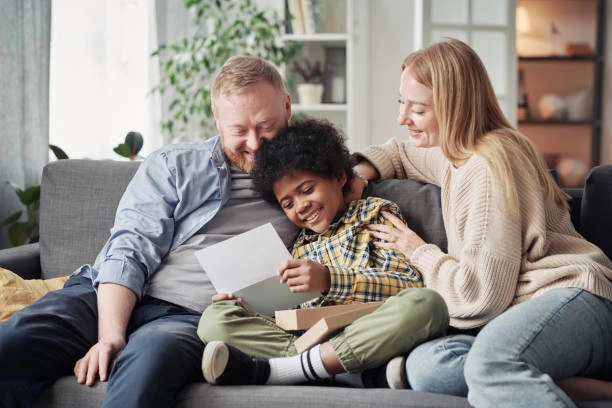Open Adoption Agreements: 7 Best Adoption Fact In Adoption

It is not that easy to navigate the complex landscape of an open adoption agreement, as it can feel like walking a tightrope between uncertainty and hope. However, these legally recognized but emotionally charged arrangements are what define the future shared by the birth parents, adoptive parent, and the adoptee at the center of it all.
Therefore, whether you are planning to go through an adoption journey or renegotiating your existing adoption agreements, understanding the rights and limitations contained in these documents will help you create a sustainable relationship that will benefit every person involved, especially the child.
The truth is that about 95% of domestic adoptions we have today involve some form of openness, but many families enter the agreement not knowing what this open adoption agreement is all about. In this comprehensive guide, I will show you everything you need to know about these vital documents that outline the adoption journey for everyone involved.
Understanding Open Adoption Agreements:
What’s An Open Adoption Agreement?
Open adoption agreements or agreements are formal documents that stipulate the nature and extent of the contract between the parties in adoption. These agreements ranged from occasion picture updates from the adoptive parents, to the regular in-person visits and the ongoing communication between the two families.
Unlike the close adoption we know decades ago, open adoption agreements capture the value of maintaining a connection between the adopted children and their birth family.
These agreements are a kind of roadmap for navigating the complex relationship and also provide structures and expectations for the parties. The basis behind open adoption agreements is so that the children will benefit from knowing their biological heritage as well as have the security of their adoptive family.
Legal Status Across States:
One of the most confusing aspects of open adoption agreements is their different legal statutes, which depend on the state or city in which one resides. As of today, about 28 states of America have different laws that make certain adoption agreements legal and enforceable in the court.
For example, in states like Oregon, Washington, and California, you will see some robust frameworks that support open adoption agreements, while others see them as moral commitments instead of contracts. In states that enforce open adoption agreements, the court can order compliance if any term is violated.
However, in these states also, judges must prioritize the child’s interest over every other thing including adherence to agreement terms. This means that open adoption agreements can sometimes be modified if need be. In states where there are no enforcement mechanisms, open adoption agreement works only on trust and goodwill between adoptive parents and the birth family.
While this poses some big risks, many adoption professionals said that relationships built on mutual respect instead of legal obligations are always more sustainable than others.
Birth Parent Rights in Open Adoption Agreements:
Communication Rights:
The birth parents are often given channels through which they can have quality communication with the adoptive family in open adoption agreements, which include.
- Having regular updates from the adoptive parents via emails, social media, or letters.
- Video and photo exchanges at various specified intervals.
- Phone, WhatsApp, or video calls from adoptive family on schedules outlined in open adoption agreements.
- In-person visitation rights (This often starts with supervised visits).
These communication rights give the birth parents the reassurance that their child is taken proper care of.
However, open adoption agreements specify that this communication doesn’t equate to co-parenting or decision-making authority.
Access To Information:
In most open adoption agreements there are always provisions for birth parents to receive information about –
- The adoptee’s educational progress and milestones.
- The child’s medical updates, (especially regarding hereditary conditions of the children )
- Major life celebrations and life events.
Changes in family circumstances:
This flow of information is to enable the birth parents to cope with their grief even as they stay connected in a meaningful way. However, this agreement has rules that limit sharing this information with others to protect the adoptive parents ‘ privacy. This flow of information helps birth parents cope with their grief while staying connected in a meaningful way.
However, open adoption agreements often have rules that limit the sharing of this information with others to protect the adoptive family’s privacy.
Limitations Birth Parents Must Understand:
While there are so many rights given to birth parents in the agreement, there are some limitations they will have to face also. This includes –
- Legal parental rights are still terminated despite the agreements.
- All the decisions rest with the adoptive parents, too.
- Contact can significantly be modified if it is not in favor of the adoptee.
- Geographic relocation may affect the workability of in-person visits.
- The agreement may become legally unenforceable if the families move to other states that don’t recognize the agreement.
If you are the biological parent, there is a need to enter the agreement with the expectation of these limitations so you don’t feel bad in the future when it happens.
Adoptive Parent Rights and Responsibilities:
Primary Authority:
The agreement of open adoption recognizes the adoptive parents are the child’s legal parents and no longer the birth mother. After the adoption is completed, the adoptive parents have the legal right to make decisions regarding that child’s –
- Education and religious upbringing.
The child’s medical and treatment decisions. - Discipline approaches and the household rules.
- The lifestyle and their daily care choices.
This authority given to the adoptive parents remains intact irrespective of the adoption agreements, though the adoptive mother commits to honoring the agreed communication plans as part of their responsibility.
Privacy Protection:
A well-written adoption agreement makes provision that protects adoptive family privacy including:
- Limitations on sharing the child’s pictures or information on social media.
- Restrictions on how the birth mother should visit the child’s school or activities when not permitted to do so.
- Ways around what personal family information should be shared.
- Boundaries about birth family contact with extended adoptive family.
These protection ethics are to help adoptive parents maintain healthy boundaries even as they still honor the spirit of openness.
The Rights To Seek Modification:
It is important to note that adoptive parents have the very right to seek the modification of the adoption agreement if circumstances change significantly or if they think the agreement is not in favor of the child. This modification process differs from state, but it typically involves medication before intervention by the court.
The Child’s Perspective in Open Adoption Agreements:
Benefits to Identity Formation:
According to research, children benefit from open adoption agreements through:
They have easy access to biological family history as well as medical information.
- Minimize the fantasy about unknown birth parents.
- Create a stronger sense of identity and self-understanding.
- Help the child by answering questions about their origins.
These benefits help in healthy identity development, especially during the adolescence stage when questions about origins are in great demand.
How To Create A Sustainable Open Adoption Agreement:
Collaborative Development Process:
A perfectly crafted adoption agreement comes from helpful conversations that address shared values about the adoptee’s well-being, clear communication protocols, and certain terms for contact frequency and type, etc.
Collaboration from all parties is needed to develop a good agreement, and all parties are expected to actively participate in discussions facilitated by counselors or mediators who understand adoption dynamics.
These professionals help to make sure that all perspectives are regarded and that the agreement is in favor of the child while respecting everyone’s boundaries.
The best and most sustainable agreements advanced from a foundation of mutual respect and were regularly reviewed to accommodate changing needs as the child matured.
By approaching the agreement as an active document rather than a rigid contract, the adoptive and birth families can create a relationship that provides secure connections for the children to their biological heritage and also maintains stability in their new homes.
Geographic Relocation Considerations in Open Adoption Agreements:
One of the greatest challenges to maintaining open adoption agreements is geographic relocation. This is when adoptive or birth families move to a very distant place from another. In this condition, the carefully crafted arrangements may require thoughtful modifications to still preserve meaningful connections as they adapt to the new realities.
The common adjustments that can be made include changing from regular in-person visits to virtual connections via video calls. The contact is adjusted frequently to conform to different time zones or changed circumstances and to establish a clear parameter about travel expenses and other responsibilities. This also helps to identify neutral meeting locations accessible to all parties involved in adoption.
The court generally sees these situations as flexible and recognizes that reasonable accommodations be made to honor the spirit of open adoption agreements even as they acknowledge practical limitations. Mediators sometimes assist families in this negotiation modification to reduce conflicts and protect the child’s best interest.
The most successful adaptations maintain consistency and predictability and also create sustainable arrangements that bridge each family’s new geographic reality.
The Future of Open Adoption Agreements:

Open adoption agreements are consistently progressing rapidly to meet modern needs. Today’s agreement has technology-specific provisions for digital and social media communication, and also expanding to include extended birth family relationships. The trend towards self-centered perspectives still emphasizes the adoptee’s needs as the agreement is established.
States that previously lacked enforcement mechanisms are gradually developing legal structures to support these agreements. Adoption experts also believe there should be continuous progress toward greater flexibility and child-focused design so more states can be granted full legal recognition of the arrangements.
As these agreements begin to mature, they are made to better serve all members of the adoption triad without compromising the adoptive family, the birth family, and the children themselves. Creating a sustainable relationship that respects everyone’s needs and rights.
Conclusion:
Open adoption agreements show a tremendous shift in how we understand family formation through the adoption process. Instead of the secrecy that has been known in adoption years back, the agreement acknowledged the complexity that adopted children belong to an extended family network that includes both adoptive and biological connections.
When you approach this with respect, child-centered focus, and honesty, this agreement can provide approaches for relationships that will benefit everyone involved.
When you understand both the rights and limitations in these agreements, families can create powerful connections that honor each person’s role in the adoption constellation.
Therefore, whether you are the biological parent who seeks reassurance about ongoing connection, or an adoptive parent who wants to navigate relationship boundaries, understanding the exigency of this agreement is paramount for creating positive adoption outcomes that serve children’s best interests.
Have in mind that while this agreement provides important roadmaps, the relationships they govern are mere human connections that require flexibility, compassion, and commitment to grow and mature with time



